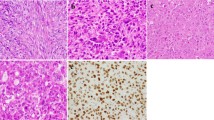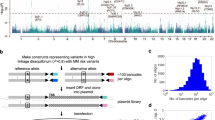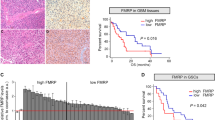Abstract
Glutamate receptors are well-known actors in the central and peripheral nervous systems, and altered glutamate signaling is implicated in several neurological and psychiatric disorders. It is increasingly recognized that such receptors may also have a role in tumor growth. Here we provide direct evidence of aberrant glutamate signaling in the development of a locally aggressive bone tumor, chondromyxoid fibroma (CMF). We subjected a series of CMFs to whole-genome mate-pair sequencing and RNA sequencing and found that the glutamate receptor gene GRM1 recombines with several partner genes through promoter swapping and gene fusion events. The GRM1 coding region remains intact, and 18 of 20 CMFs (90%) showed a more than 100-fold and up to 1,400-fold increase in GRM1 expression levels compared to control tissues. Our findings unequivocally demonstrate that direct targeting of GRM1 is a necessary and highly specific driver event for CMF development.
This is a preview of subscription content, access via your institution
Access options
Subscribe to this journal
Receive 12 print issues and online access
$209.00 per year
only $17.42 per issue
Buy this article
- Purchase on Springer Link
- Instant access to full article PDF
Prices may be subject to local taxes which are calculated during checkout


Similar content being viewed by others
References
Romeo, S. et al. Chondromyxoid fibroma resembles in vitro chondrogenesis, but differs in expression of signalling molecules. J. Pathol. 206, 135–142 (2005).
Romeo, S., Aigner, T. & Bridge, J.A. in WHO Classification of Tumours of Soft Tissue and Bone (eds. Fletcher, C.D.M., Bridge, J.A., Hogendoorn, P.C.W. & Mertens, F.) 255–256 (IARC, Lyon, France, 2013).
Romeo, S. et al. Heterogeneous and complex rearrangements of chromosome arm 6q in chondromyxoid fibroma: delineation of breakpoints and analysis of candidate target genes. Am. J. Pathol. 177, 1365–1376 (2010).
Yasuda, T. et al. Aberrations of 6q13 mapped to the COL12A1 locus in chondromyxoid fibroma. Mod. Pathol. 22, 1499–1506 (2009).
Mertens, F. et al. The t(X;6) in subungual exostosis results in transcriptional deregulation of the gene for insulin receptor substrate 4. Int. J. Cancer 128, 487–491 (2011).
Scott, D.W. et al. TBL1XR1/TP63: a novel recurrent gene fusion in B-cell non-Hodgkin lymphoma. Blood 119, 4949–4952 (2012).
Leupin, O. et al. Control of the SOST bone enhancer by PTH using MEF2 transcription factors. J. Bone Miner. Res. 22, 1957–1967 (2007).
Willard, S.S. & Koochekpour, S. Glutamate signaling in benign and malignant disorders: current status, future perspectives, and therapeutic implications. Int. J. Biol. Sci. 9, 728–742 (2013).
Mehta, M.S. et al. Metabotropic glutamate receptor 1 expression and its polymorphic variants associate with breast cancer phenotypes. PLoS ONE 8, e69851 (2013).
Namkoong, J. et al. Metabotropic glutamate receptor 1 and glutamate signaling in human melanoma. Cancer Res. 67, 2298–2305 (2007).
Martino, J.J. et al. Metabotropic glutamate receptor 1 (Grm1) is an oncogene in epithelial cells. Oncogene 32, 4366–4376 (2013).
Prickett, T.D. et al. Exon capture analysis of G protein–coupled receptors identifies activating mutations in GRM3 in melanoma. Nat. Genet. 43, 1119–1126 (2011).
Choi, K.Y., Chang, K., Pickel, J.M., Badger, J.D. II & Roche, K.W. Expression of the metabotropic glutamate receptor 5 (mGluR5) induces melanoma in transgenic mice. Proc. Natl. Acad. Sci. USA 108, 15219–15224 (2011).
Ciceroni, C. et al. Type-3 metabotropic glutamate receptors regulate chemoresistance in glioma stem cells, and their levels are inversely related to survival in patients with malignant gliomas. Cell Death Differ. 20, 396–407 (2013).
Chang, H.J. et al. Metabotropic glutamate receptor 4 expression in colorectal carcinoma and its prognostic significance. Clin. Cancer Res. 11, 3288–3295 (2005).
Savage, S.A. et al. Genome-wide association study identifies two susceptibility loci for osteosarcoma. Nat. Genet. 45, 799–803 (2013).
Chenu, C., Serre, C.M., Raynal, C., Burt-Pichat, B. & Delmas, P.D. Glutamate receptors are expressed by bone cells and are involved in bone resorption. Bone 22, 295–299 (1998).
Wang, L., Hinoi, E., Takemori, A., Takarada, T. & Yoneda, Y. Abolition of chondral mineralization by group III metabotropic glutamate receptors expressed in rodent cartilage. Br. J. Pharmacol. 146, 732–743 (2005).
Wang, L., Hinoi, E., Takemori, A., Nakamichi, N. & Yoneda, Y. Glutamate inhibits chondral mineralization through apoptotic cell death mediated by retrograde operation of the cystine/glutamate antiporter. J. Biol. Chem. 281, 24553–24565 (2006).
Wang, L., Hinoi, E., Takemori, A. & Yoneda, Y. Release of endogenous glutamate by AMPA receptors expressed in cultured rat costal chondrocytes. Biol. Pharm. Bull. 28, 990–993 (2005).
Genever, P.G. & Skerry, T.M. Regulation of spontaneous glutamate release activity in osteoblastic cells and its role in differentiation and survival: evidence for intrinsic glutamatergic signaling in bone. FASEB J. 15, 1586–1588 (2001).
Mandahl, N. in Human Cytogenetics: Malignancy and Acquired Abnormalities (ed. Rooney, D.E.) 165–203 (Oxford University Press, New York, 2001).
Shaffer, L.G., McGowan-Jordan, J. & Schmid, M. ISCN (2013): An International System for Human Cytogenetic Nomenclature (S. Karger, Basel, Switzerland, 2013).
Nord, K.H. et al. Concomitant deletions of tumor suppressor genes MEN1 and AIP are essential for the pathogenesis of the brown fat tumor hibernoma. Proc. Natl. Acad. Sci. USA 107, 21122–21127 (2010).
Iafrate, A.J. et al. Detection of large-scale variation in the human genome. Nat. Genet. 36, 949–951 (2004).
Carver, T. et al. BamView: visualizing and interpretation of next-generation sequencing read alignments. Brief. Bioinform. 14, 203–212 (2013).
Kim, D. et al. TopHat2: accurate alignment of transcriptomes in the presence of insertions, deletions and gene fusions. Genome Biol. 14, R36 (2013).
Mohajeri, A. et al. Comprehensive genetic analysis identifies a pathognomonic NAB2/STAT6 fusion gene, nonrandom secondary genomic imbalances, and a characteristic gene expression profile in solitary fibrous tumor. Genes Chromosom. Cancer 52, 873–886 (2013).
Jin, Y. et al. Fusion of the AHRR and NCOA2 genes through a recurrent translocation t(5;8)(p15;q13) in soft tissue angiofibroma results in upregulation of aryl hydrocarbon receptor target genes. Genes Chromosom. Cancer 51, 510–520 (2012).
Rossi, S. et al. EWSR1-CREB1 and EWSR1-ATF1 fusion genes in angiomatoid fibrous histiocytoma. Clin. Cancer Res. 13, 7322–7328 (2007).
Acknowledgements
We are grateful for the expert technical assistance of M. Rissler. We acknowledge help with the microarray analyses from the Swegene Centre for Integrative Biology at Lund University, support from the Science for Life Laboratory, the National Genomics Infrastructure (NGI), Sweden, and the Knut and Alice Wallenberg Foundation, and UPPMAX for providing assistance with massively parallel DNA sequencing and computational infrastructure. This work was supported by the Magnus Bergvall Foundation, the Royal Physiographic Society (Lund, Sweden) and the Swedish Childhood Cancer Foundation.
Author information
Authors and Affiliations
Contributions
K.H.N., H.L., J.V.M.G.B., P.C.W.H. and K.S. conceived and designed the experiments. J.N. and K.H.N. analyzed SNP array data. H.L., K.H.N. and J.T. carried out bioinformatic analyses of RNA sequencing data and global gene expression data. F.V. developed an algorithm for the analysis of DNA mate-pair sequencing data. F.V., K.S. and K.H.N. analyzed DNA mate-pair sequencing data and interpreted the results. J.N. and L.M. conducted RT-PCR and RT-qPCR experiments. L.M., D.d.J. and K.S. performed FISH analyses. K.H.N. prepared the manuscript with contributions from all other authors.
Corresponding author
Ethics declarations
Competing interests
The authors declare no competing financial interests.
Integrated supplementary information
Supplementary Figure 1 Structural rearrangements of regions immediately upstream or downstream of the GRM1 gene.
In case 1, six mate pairs were identified with one partner located 3′ (downstream) of the GRM1 gene and the other partner situated in the 5′ part of COL12A1. A possible explanation for this distribution of mate pairs could be an insertion of GRM1 into the 5′ part of COL12A1. This would place the expression of GRM1 under the control of the COL12A1 promoter. In line with these findings, COL12A1 and GRM1 were also rearranged in case 2. However, in this case, eight mate pairs were located 3′ of COL12A1 and 5′ of GRM1. In addition, seven mate pairs were situated in the 3′ part of COL12A1 in combination with more proximal mates 5′ of GRM1. This combination of mate pairs suggests an inversion involving parts of chromosome arm 6q, which results in altered GRM1 expression under the influence of the COL12A1 promoter. In case 4, six mate pairs were identified with one partner 5′ of GRM1 and the other mate located in the 5′ part of the TBL1XR1 gene at 3q26. The orientation of the genes precludes any functional outcome of a simple translocation between 6q24 and 3q26. However, the orientation of the sequence reads demonstrated that there was an inversion associated with the rearrangement, and SNP array data in this case showed a deletion immediately upstream of GRM1. The 5′ part of TBL1XR1 could thus have been inserted 5′ of GRM1, which would place the expression of GRM1 under the control of the TBL1XR1 promoter. In case 5, 12 mate pairs were detected with 1 mate situated in the 5′ part of BCLAF1 at 6q23 and the other mate 5′ of GRM1. This suggests that there is an inversion resulting in altered GRM1 expression under the influence of the BCLAF1 promoter.
Supplementary Figure 2 Structural rearrangements of the regions immediately upstream of GRM1 detected by FISH.
Probes mapping to sequences within (red) and upstream of (green) the GRM1 gene were used to detect rearrangement of the GRM1 promoter region. In five investigated cases (cases 2, 5, 7, 8 and 17), split signals were found in more than 20% (range of 31–79%) of the analyzed nuclei. In an additional five cases (cases 4 and 18–21), split signals could not be confirmed in more than 20% of the analyzed nuclei. In case 4, which was negative in FISH analysis, rearrangement of the GRM1 promoter was detected by both DNA mate-pair sequencing and SNP array analyses. Thus, the relatively low resolution of interphase FISH analysis precludes the detection of GRM1 promoter rearrangement in cases with complex genomic aberrations, involving, for example, loss of segments upstream of GRM1.
Supplementary information
Supplementary Text and Figures
Supplementary Figures 1 and 2, and Supplementary Tables 1, 2, 5 and 6 (PDF 1128 kb)
Supplementary Table 3
DNA mate-pair sequencing of chondromyxoid fibroma. (XLSX 170 kb)
Supplementary Table 4
(a) Affymetrix gene expression data on GRM1 from 174 bone and soft-tissue tumors (Affymentrix Human Gene 1.0 ST array data in house). (b) GRM1 is upregulated in chondromyxoid fibroma. Downstream effectors of GRM1 activation such as AKT2, MAPK1 and BCL2 are expressed in CMF as well as in other mesenchymal tumor and normal tissues and do not constitute specific markers for GRM1 activation in CMF. (c) GRM1 shows very low or no expression in non-CMF chondrogenic and osteogenic bone tumor samples and cell lines (Affymentrix Human Gene 1.0 ST array data from public data sets GSE35545, GSE12865, GSE39795, GSE32395 and GSE19357, GEO). GRM1 shows low but detectable expression in normal chondrocytes. The investigated bone tumors most frequently show expression of GRM4-GRM6. Expression levels of >5 is indicated in red (the noise level of the array is <4.5–5). (XLSX 45 kb)
Source data
Rights and permissions
About this article
Cite this article
Nord, K., Lilljebjörn, H., Vezzi, F. et al. GRM1 is upregulated through gene fusion and promoter swapping in chondromyxoid fibroma. Nat Genet 46, 474–477 (2014). https://doi.org/10.1038/ng.2927
Received:
Accepted:
Published:
Issue Date:
DOI: https://doi.org/10.1038/ng.2927
This article is cited by
-
Subcutaneous chondromyxoid fibroma with a novel PNISR::GRM1 fusion—report of a primary soft tissue tumour without connection to an underlying bone
Virchows Archiv (2023)
-
Update from the 5th Edition of the World Health Organization Classification of Head and Neck Tumors: Odontogenic and Maxillofacial Bone Tumours
Head and Neck Pathology (2022)
-
Recurrent novel THBS1-ADGRF5 gene fusion in a new tumor subtype “Acral FibroChondroMyxoid Tumors”
Modern Pathology (2020)
-
Molekulare Pathologie in der Diagnostik der Knochentumoren: Aktueller Stand
Der Pathologe (2020)
-
Diagnostische Herausforderungen bei Knorpeltumoren
Der Orthopäde (2019)



